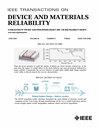An Empirical Study on Fault Detection and Root Cause Analysis of Indium Tin Oxide Electrodes by Processing S-Parameter Patterns
IF 2.5
3区 工程技术
Q2 ENGINEERING, ELECTRICAL & ELECTRONIC
IEEE Transactions on Device and Materials Reliability
Pub Date : 2024-06-17
DOI:10.1109/TDMR.2024.3415049
引用次数: 0
Abstract
In the field of optoelectronics, indium tin oxide (ITO) electrodes play a crucial role in various applications, such as displays, sensors, and solar cells. Effective fault diagnosis and root cause analysis of the ITO electrodes are essential to ensure the performance and reliability of the devices. However, traditional visual inspection is challenging with transparent ITO electrodes, and existing fault diagnosis methods have limitations in determining the root causes of the defects, often requiring destructive evaluations and secondary material characterization techniques. In this study, a fault diagnosis method with root cause analysis is proposed using scattering parameter (S-parameter) patterns, offering early detection, high diagnostic accuracy, and noise robustness. A comprehensive S-parameter pattern database is obtained according to various defect states of the ITO electrodes. Deep learning (DL) approaches, including multilayer perceptron (MLP), convolutional neural network (CNN), and transformer, are then used to simultaneously analyze the cause and severity of defects. Notably, it is demonstrated that the diagnostic performance under additive noise levels can be significantly enhanced by combining different channels of the S-parameters as input to the learning algorithms, as confirmed through the t-distributed stochastic neighbor embedding (t-SNE) dimension reduction visualization of the S-parameter patterns.通过处理 S 参数模式进行氧化铟锡电极故障检测和根本原因分析的实证研究
在光电子领域,铟锡氧化物(ITO)电极在显示器、传感器和太阳能电池等各种应用中发挥着至关重要的作用。要确保设备的性能和可靠性,就必须对 ITO 电极进行有效的故障诊断和根本原因分析。然而,对于透明的 ITO 电极来说,传统的目视检测具有挑战性,而且现有的故障诊断方法在确定缺陷的根本原因方面存在局限性,通常需要进行破坏性评估和二次材料表征技术。本研究提出了一种利用散射参数(S 参数)模式进行根本原因分析的故障诊断方法,具有早期检测、诊断准确性高和噪声稳健性好的特点。根据 ITO 电极的各种缺陷状态,获得了一个全面的 S 参数模式数据库。然后使用深度学习(DL)方法,包括多层感知器(MLP)、卷积神经网络(CNN)和变压器,同时分析缺陷的原因和严重程度。值得注意的是,通过对 S 参数模式进行 t 分布随机邻域嵌入(t-SNE)降维可视化,证明了将不同通道的 S 参数组合作为学习算法的输入,可显著提高加性噪声水平下的诊断性能。
本文章由计算机程序翻译,如有差异,请以英文原文为准。
求助全文
约1分钟内获得全文
求助全文
来源期刊

IEEE Transactions on Device and Materials Reliability
工程技术-工程:电子与电气
CiteScore
4.80
自引率
5.00%
发文量
71
审稿时长
6-12 weeks
期刊介绍:
The scope of the publication includes, but is not limited to Reliability of: Devices, Materials, Processes, Interfaces, Integrated Microsystems (including MEMS & Sensors), Transistors, Technology (CMOS, BiCMOS, etc.), Integrated Circuits (IC, SSI, MSI, LSI, ULSI, ELSI, etc.), Thin Film Transistor Applications. The measurement and understanding of the reliability of such entities at each phase, from the concept stage through research and development and into manufacturing scale-up, provides the overall database on the reliability of the devices, materials, processes, package and other necessities for the successful introduction of a product to market. This reliability database is the foundation for a quality product, which meets customer expectation. A product so developed has high reliability. High quality will be achieved because product weaknesses will have been found (root cause analysis) and designed out of the final product. This process of ever increasing reliability and quality will result in a superior product. In the end, reliability and quality are not one thing; but in a sense everything, which can be or has to be done to guarantee that the product successfully performs in the field under customer conditions. Our goal is to capture these advances. An additional objective is to focus cross fertilized communication in the state of the art of reliability of electronic materials and devices and provide fundamental understanding of basic phenomena that affect reliability. In addition, the publication is a forum for interdisciplinary studies on reliability. An overall goal is to provide leading edge/state of the art information, which is critically relevant to the creation of reliable products.
 求助内容:
求助内容: 应助结果提醒方式:
应助结果提醒方式:


